Copyright 2020 - 2021 irantour.tours all right reserved
Designed by Behsazanhost
Nourabad's Historical Sites
Nourabad's Historical Sites
Nurabad-Mamasani
Located in the northwestern part of Fars, the region of Mamasani occupies an area of about 15,000 sq. km. It is situated west of the Zagros mountain range at a height of 900 m above sea level. The center of the region - Nurabad - is located 165 km northwest of Shiraz. The history of Mamasani goes back at least 5,000 years ago. The region is known to have been a part of the Anshan realm under the Elamites. The Elamite bas-relief of Kurangun, dating from around 2,500 B.C. is among the best-preserved of the relics from this period. During the Median period, the region retained its importance, as clearly shown by the monuments of Dav-Dokhtar and Mil-e Ezhdeha. Mamasani seems to have gained even more prominent status under the Achaemenid kings. The relics found in the town of Sarvan exhibit the same elements of Achaemenid architecture employed during the construction of Apadana palaces both in Susa and Persepolis and probably date from the time of Darius the Great. Mamasani remained part of the Anshan satrapy until the end of the Achaemenid rule. Some historians believe that the decisive battle between the army of Alexander the Great and the Iranian troops led by the famous general Aryo Barzan took place somewhere within the limits of modern Mamasani. By what name Mamasani was called during the Seleucid and Parthian periods, we do not know.
The most important historical sites in this area are:
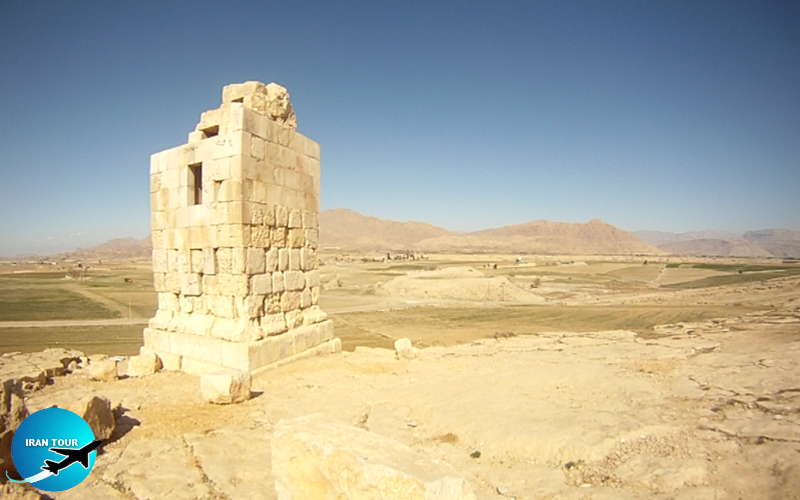 |
-Dragon's Column
The Dragon's Column is located 7 km west of Nurabad, at the foot of Mt. Tang-e Kaleh. This rectangular tower somewhat resembles the buildings of Solomon's Prison at Pasargadae and Zoroaster's Kaaba at Naqsh-e Rostam. Like them, it has not been completely explained as to its purpose. Many believe that the building of Mil-e Ezhdeha was a fire temple, with a fire kept alight on its roof, while others claim that it was used to store sacred archives. Nor has the exact date of the monument been established, and it is attributed alternatively to either the Median or Parthian periods. The tower is made of regular courses of calcareous stone, precisely fitted together, and bound with gypsum mortar. The stone courses vary in width from 44 to 65 cm, and the stones are also of varying length, some being 44 cm, and others only 19 cm long.
The building is more than 7 m high. The upper part of its sides is about 3.5 m wide, but the lower part has been made wider through the use of stones skillfully trimmed and shaped so that the width of each side at the base is about 4 m. Inside the upper section of the tower is a staircase about 1 m long and 60 cm wide; these winds inside the structure like the staircases of minarets. Its opening is on the south side, facing the mountain. It is placed at a height of 3 m from the ground and must have been reached by a ladder. A four-cornered stone, believed to have been a brazier, was found lying broken at the foot of the tower. In order to preserve this stone, it was transferred to the National Museum in Tehran.
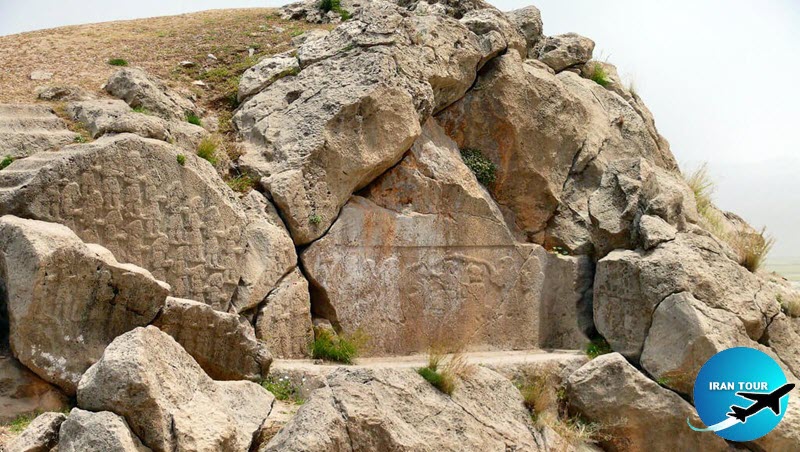 |
- Kurangun Bas-relief
The famous bas-relief of Kurangun is carved on a rocky promontory of Mt. Kurangun, about 20 km northwest of Nurabad. According to archaeological research, it may be a worship or ritual site of the Elamite period, highly influenced in style by Sumerian art. The engraving dates from about 2,400 B.C. and must have been carved at the order of local Anshan rulers. Considering its extremely ancient origin, the Kurangun bas-relief is fairly well-preserved. Its principal scene shows a pair of deities, a female and a male, surrounded by a number of people standing on both sides, and facing them. The male divinity sits on a throne formed by a curled-up snake. He holds the snake's head in his left hand, while in his right hand he has a jug, from which two jets of water are spouting. The first jet is directed at the three worshippers facing him and standing behind the altar at his right side, while the second gushes over his head toward two other devotees behind the god, and to his left.
The goddess is seated at the god's side, slightly beside him. Both the god and the goddess are attired in long garments and wear crowns with two horns. Twenty-seven persons in rather short tunics are engraved on a separate stone panel, opposite the main scene. All the figures are seen in profile, an interesting feature that later exerted a definite influence on Achaemenid art. There may have been forty of these figures, but the rest have crumbled away. The same subject depicted in Kurangun | also existed in Naqsh-e Rostam until the carving of Bahram II was engraved on top of it. It proves that the influence of the Elamites expanded far beyond their eastern boundaries - at least as far as Naqsh-e Rostam in Marvdasht.
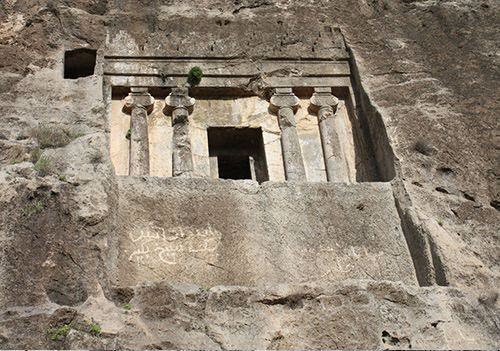 |
- Dav Dokhtar Stone Ossuary
Dav Dokhtar üsglo About 30 km northwest of Nurabad, an ancient tomb is hollowed out of the rock at a height of some 200 m above the ground. In the local dialect, the place is properly called Dayo-Dumidar, meaning "the Mother and the Daughter". Many regard this tomb as belonging to the Median period and have expressed the opinion that it was made between the years 650 and 550 B.C. Some scholars have assigned it to one of the Achaemenid monarchs prior to Cyrus the Great, perhaps Teispes or Cyrus I. Still, others suggest that it may have been created by the end of the Achaemenid reign, perhaps to house the grave of some local ruler. There even exists the opinion that it was the grave of Aryo Barzan, the celebrated Iranian general, killed in the battle with Alexander the Great.
Externally, the tomb brings to mind the Achaemenid mausoleums. A pair of partially embedded columns in a degenerated proto-Ionian style stand on either side of the entrance. Their base is formed by a high torus on a double plinth, and they have smooth shafts which bear an architrave that ends in a scroll on either side. Above the columns, there is a cornice of flat, polished stone in three layers, surmounted by a frieze of seven stepped, half-lozenge crenellations carved in relief into a stone. The lower part consists of a long, wide, smoothed panel. Inside, the ossuary consists of two tomb-chambers, which, although half-completed, yet reveal the remarkable craftsmanship of the tomb's stonemasons.
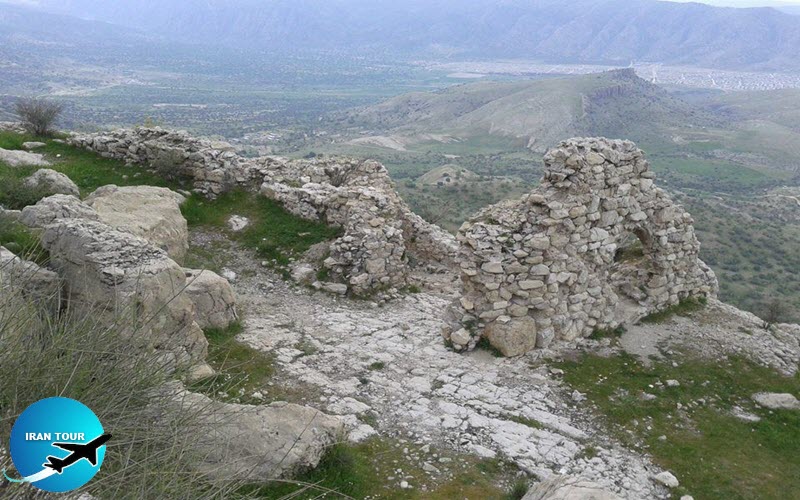 |
- White Fort
Qal'e-ye Sefid (the White Fort), so-called for the color of the rock, is one of the most famous fortresses in Fars. A citadel of rough-hewn stone and mortar, and a wonderful natural stronghold, it stands on an isolated mountain peak with perpendicular sides, towering over the environs about 15 km north of Nurabad. There used to be four routes to get to the citadel, but only one path - that hewn in the face of the rock and called Shotore Khosb ("the Drowsy Camel") - is accessible today. The remains of a rampart, a stone gate, and a stone entrance arch are still traceable. The entrance was closed by an iron door that was later removed to Imamzadeh Darb-e Ahanin ("The Iron Door"). The history of the White Fort reaches back into the remotest antiquity. Some believe that this is the same fort mentioned by Ferdowsi in the Shahnameh when he says:
It is believed that the legendary Rostam took the fort only by stratagem, sending in his soldiers in salt-bags. For a while, the fortress withstood the armies of Alexander the Great. In the 11th century, it gave shelter to Ismailites, until they were defeated by the Mongol troops of Hulaku Khan. The fortress was a prison for Mozaffar al-Din Shah, confined there by his son Shah Shoja. Timur captured it with the aid of local climbers and released Zein al-Abedin, who was imprisoned there by his cousin Shah Mansur. Toward the latter part of Fathali Shah's reign, the Mamasani tribesmen, under the redoubtable chieftain Vali Khan Bakash, were in constant rebellion, having made the White Fort their headquarters. An army of Azerbaijan troops marched against them and besieged the fortress, which was at length forced to surrender. Nearly one hundred of the women, however, rather than fall into the hands of the Turkish soldiery, hurled themselves and their children from the summit, and perished. The citadel was used till the time of Mohammad Shah Qajar, and even later it gave shelter to local rebels.
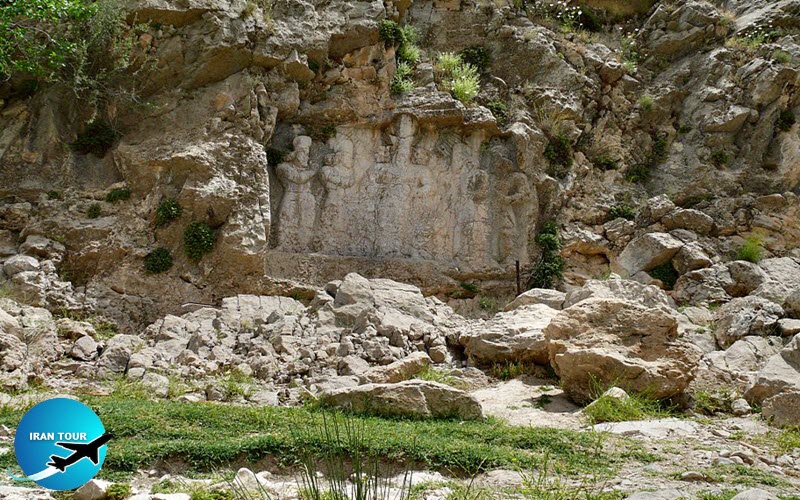 |
-Bas-relief of Sarab-e Bahram
On the way from Nurabad to Kazerun, on the left-hand side of the road at a distance of about 9 km from the city is an enchanting site known as Sarab-e Bahram. The bas-relief, engraved on a mountain slope, is about 4 m long and 3 m wide. It portrays Bahram II, on either side of whom two Sasanid dignitaries stand with forefingers raised as a symbol of respect to their sovereign. Some guess that the figure on the right may be Kartir. Bahram II, whose portrait is also engraved at Naqsh-e Rostam, Sar-Mashhad, and the Chogan Gorge, is here seen seated in the center of the carving, facing the viewer. Because the relief omits the figure of the king's successor, it is believed that it was carved before the successor was appointed, i.e. about 280. A gushing water spring and verdant myrtles add significantly to the beauty of the site.
- Bas-relief of Naqsh-e Qandil
Another Sasanid bas-relief can be found in Qandil Village, located along the Nurabad-Kazerun road, 4 km before Qaemiyeh. Most experts believe that the engraving is a picture of Shapur I presenting flowers to his wife, Azar Anahita, in the presence of a Sasanid nobleman, who stands beside the king. Some, however, have seen the deity Anahita in the female figure, and the high priest Kartir in the figure of the nobleman. If so, the scene may depict the deity granting a wreath of royalty to the monarch.
- Details
- Category: Museums of Shiraz